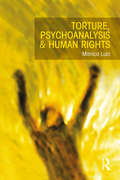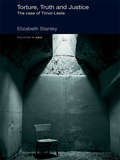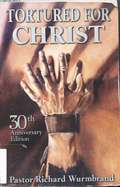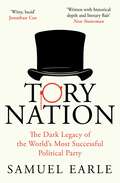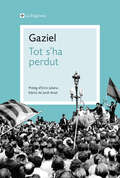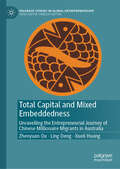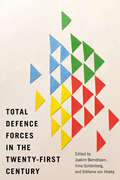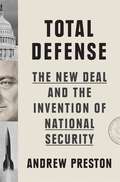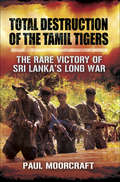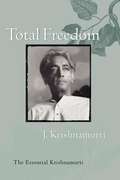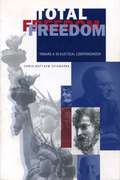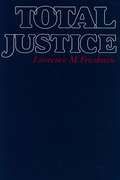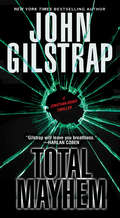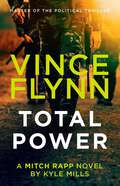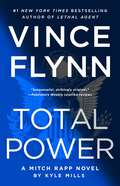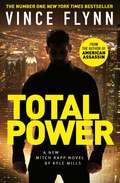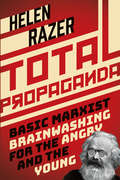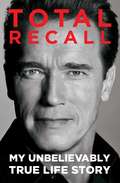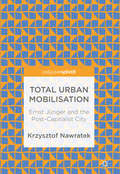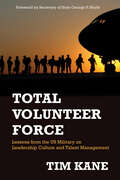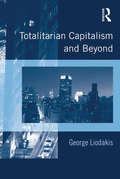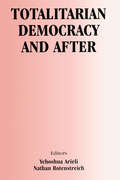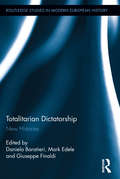- Table View
- List View
Torture, Psychoanalysis and Human Rights
by Monica LuciTorture, Psychoanalysis and Human Rights contributes to the development of that field of study called ‘psycho-social’ that is presently more and more committed to providing understanding of social phenomena, making use of the explicative perspective of psychoanalysis. The book seeks to develop a concise and integrated framework of understanding of torture as a socio-political phenomenon based on psychoanalytic thinking, through which different dimensions of the subject of study become more comprehensible. Monica Luci argues that torture performs a covert emotional function in society. In order to identify what this function might be, a profile of ‘torturous societies’ and the main psychological dynamics of social actors involved – torturers, victims, and bystanders – are drawn from literature. Accordingly, a wide-ranging description of the phenomenology of torture is provided, detecting an inclusive and recurring pattern of key elements. Relying on psychoanalytic concepts derived from different theoretical traditions, including British object relations theories, American relational psychoanalysis and analytical psychology, the study provides an advanced line of conceptual research, shaping a model, whose aim is tograsp the deep meaning of key intrapsychic, interpersonal and group dynamics involved in torture. Once a sufficiently coherent understanding has been reached, Luci proposes using it as a groundwork tool in the human rights field to re-think the best strategies of prevention and recovery from post-torture psychological and social suffering. The book initiates a dialogue between psychoanalysis and human rights, showing that the proposed psychoanalytic understanding is a viable conceptualisation for expanding thinking of crucial issues regarding torture, which might be relevant to human rights and legal doctrine, such as the responsibility of perpetrators, the reparation of victims and the question of ‘truth’. Torture, Psychoanalysis and Human Rights is the first book to build a psychoanalytic theory of torture from which psychological, social and legal reflections, as well as practical aspects of treatment, can be mutually derived and understood. It will appeal to psychoanalysts, psychoanalytic psychotherapists and Jungians, as well as scholars of politics, social work and justice, and human rights and postgraduate students studying across these fields.
Torture, Truth and Justice: The Case of Timor-Leste (Politics in Asia)
by Elizabeth StanleyThis book highlights how, and why, torture is such a compelling tool for states and other powerful actors. While torture has a short-term use value for perpetrators, it also creates a devastating legacy for victims, their families and communities. In exposing such repercussions, this book addresses the questions ‘What might torture victims need to move forward from their violation?’ and ‘How can official responses provide truth or justice for torture victims?’ Building on observations, documentary analysis and over seventy interviews with both torture victims and transitional justice workers this book explores how torture was used, suffered and resisted in Timor-Leste. The author investigates the extent to which transitional justice institutions have provided justice for torture victims; illustrating how truth commissions and international courts operate together and reflecting on their successes and weaknesses with reference to wider social, political and economic conditions. Stanley also details victims’ experiences of torture and highlights how they experience life in the newly built state of Timor-Leste Tracking the past, present and future of human rights, truth and justice for victims in Timor-Leste, Torture, Truth and Justice will be of interest to students, professionals and scholars of Asian studies, International Studies, Human Rights and Social Policy.
Tortured Logic: Why Some Americans Support the Use of Torture in Counterterrorism (Columbia Studies In Terrorism And Irregular Warfare Ser.)
by Joseph Young Erin M. KearnsExperts in the intelligence community say that torture is ineffective. Yet much of the public appears unconvinced: surveys show that nearly half of Americans think that torture can be acceptable for counterterrorism purposes. Why do people persist in supporting torture—and can they be persuaded to change their minds?In Tortured Logic, Erin M. Kearns and Joseph K. Young draw upon a novel series of group experiments to understand how and why the average citizen might come to support the use of torture techniques. They find evidence that when torture is depicted as effective in the media, people are more likely to approve of it. Their analysis weighs variables such as the ethnicity of the interrogator and the suspect; the salience of one’s own mortality; and framing by experts. Kearns and Young also examine who changes their opinions about torture and how, demonstrating that only some individuals have fixed views while others have more malleable beliefs. They argue that efforts to reduce support for torture should focus on convincing those with fluid views that torture is ineffective. The book features interviews with experienced interrogators and professionals working in the field to contextualize its findings. Bringing empirical rigor to a fraught topic, Tortured Logic has important implications for understanding public perceptions of counterterrorism strategy.
Tortured for Christ, 30th anniversary edition
by Richard WurmbrandThis 30th anniversary edition of "Tortured for Christ" is the original testimony of a pastor's fourteen-year imprisonment under a Romanian dictatorship. The author says he has written this book, with pen and tears, only three days shortly after his release from prison.
Tory Nation: How one party took over
by Samuel Earle&‘A witty, lucid investigation into one of the great political mysteries of our time: the enduring love felt by the British people for the party which regularly manages to persuade them, against all the evidence, that it has their best interests at heart&’ JONATHAN COE, author of Bournville _________________________________________________________________________________The story of the most successful political party in the world, and a nation made in its image. Since 2010, the Conservative Party has presided over countless corruption scandals, blundered its way through a pandemic and trapped Britain in a cycle of permanent dysfunction. This has coincided with four election wins in a row, each one with a larger share of the vote than the last. How? The strange dissonance between the Conservatives&’ destructive record in government and their record of victory – which has seen them suffer only seven major defeats in the last 150 years – is one of the defining riddles of British politics. Tory Nation sets out to solve this puzzle. With dazzling clarity and insight, Samuel Earle explores the roots of the current crisis and the real reasons for the Conservatives&’ success, from their ruling class origins in the eighteenth century and their disproportionate influence on the British press to their stranglehold over national identity. He also sheds light on the Conservatives&’ historic appeal among the working classes and why the Labour Party so often disappoints. Tory Nation describes the making of Britain through one party&’s astonishing staying power. It&’s only by reaching into our history, Earle argues, that we can understand how we got here – and how we can find a way out _________________________________________________________________________________'Finally, someone has explained why the British electorate behaves like Turkeys voting for Christmas. Sam Earle has set out clearly and eloquently why our democracy is incapable of solving our political problems' ROBERT VERKAIK, author of Posh Boys&‘Eviscerating. Less a political book and more a mystery novel . . . untangles the riddle of the strange cognitive dissonance between the Tories&’ bumbling, destructive political record and their inexplicable electoral success&’i-D
Tot s'ha perdut
by Agustí CalvetEl magnífic recull d'articles que GAZIEL va publicar a La Vanguardia entre els anys 1922 i 1934 on explicava, amb una gran visió crítica, una realitat política que sorprenentment és ben pastada a l'actual. «No busquemos, pues, ninguna explicación absurda a nuestro infortunio, ya que la única y principal es muy clara. Los culpables de cuanto le ocurre a Cataluña somos los catalanes. Los partidos que nos representaron, y nosotros que les indujimos a que lo hicieran tan mal. Y esto es todo. [...] Un día saldremos de este negro pozo en que caímos. Pero que, en adelante, nos sirva esta clara lección: solo podremos triunfar en España yendo todos los catalanes fuertemente unidos, como una irrompible falange, y además sólidamente abrazados con el mayor número posible de españoles hermanos». Aquestes paraules que Gaziel va escriure el 21 de desembre de 1934 a La Vanguardia encara ressonen avui.Pot ser quegairebé un segle després visquem amb la sensació ben viva que «tot s'ha perdut»? Com diu Jordi Amat a la nota a l'edició, «Gaziel va seleccionar intencionadament uns articles i no pas uns altres pel seu contingut, perquè volia traçar una crònica, la seva, d'uns anys capitals de la política catalana i del moviment catalanista». Us animem a recuperar-los i a llegir-los des de la distància dels anys amb la seguretat que bona part de les reflexions crítiques i lúcides d'Agustí Calvet ens donaran la clau per interpretar el nostre present i bastir-lo de nou. PRÒLEG D'ENRIC JULIANAEDICIÓ DE JORDI AMAT
Total Capital and Mixed Embeddedness: Unravelling the Entrepreneurial Journey of Chinese Millionaire Migrants in Australia (Palgrave Studies in Global Entrepreneurship)
by Xueli Huang Ling Deng Zhenyuan QuThis book focuses on the experiences of Chinese migrant entrepreneurs in Australia, exploring the challenges they face and the strategies they use to succeed in the business sector. Using interviews and in-depth case studies, and personal reflections, the book provides a rich narrative of personal and business experiences of these entrepreneurs. By exploring the real-life experiences of Chinese migrant entrepreneurs in Australia, the authors offer a deep dive into their daily lives and business operations and thereby providing detailed insights into their challenges and strategies. Whilst highlighting the main challenges such as cultural differences, language barriers, and difficulties in accessing resources, the book identifies the strategies Chinese migrant entrepreneurs use to overcome these challenges, including leveraging social networks and community support. Readers will find the discussion on how cultural differences affect business operations particularly interesting, as it provides a nuanced understanding of cross-cultural entrepreneurship. They would also be interested in the research into how Chinese business migrants contribute to Australia's innovation ecosystem through introducing new ideas and technologies, which is a key topic for understanding the broader economic impact of Chinese business migrants to Australia.
Total Defence Forces in the Twenty-First Century (Human Dimensions in Foreign Policy, Military Studies, and Security Studies #20)
by Stéfanie Von Hlatky Irina Goldenberg Joakim BerndtssonTotal defence, as a concept, combines and extends military and civil defence: in a state of war or emergency, all social institutions mobilize to defend the state. Total defence forces, led by a diverse workforce of defence and security professionals, are critical to both national defence and international security goals.Total Defence Forces in the Twenty-First Century looks at the various groups that make up this workforce: members of the military’s regular force, reservists, defence civil servants, and contractors working for private military and security companies. When civilian staff and military personnel work towards a common goal, their distinct professional cultures and identities can make integration challenging. Despite the often high levels of partnership, underlying differences affect the quality of the collaboration and, ultimately, organizational and operational effectiveness. Defence ministries around the world are increasingly recognizing the importance of optimizing the ways in which they employ and integrate civilian and military personnel.This volume focuses on a critical question: what are the main challenges to workforce integration and collaboration, and how can such challenges be overcome to deliver the full potential of the total defence force? Together, scholars and practitioners provide some answers.
Total Defense: The New Deal and the Invention of National Security
by Andrew PrestonThe story of how FDR and fellow New Dealers created the idea of national security, transforming the meaning of defense and vastly expanding the US government’s responsibilities.National security may seem like a timeless notion. States have always sought to fortify themselves, and the modern state derives its legitimacy from protecting its population. Yet national security in fact has a very particular, very American, history—and a surprising one at that.The concept of national security originates in the 1930s, as part of a White House campaign in response to the rise of fascism. Before then, national self-defense was defined in terms of protecting sovereign territory from invasion. But President Franklin D. Roosevelt and his circle worried that the US public, comforted by two vast oceans, did not take seriously the long-term risks posed by hypermilitarization abroad. New Dealers developed the doctrine of national security, Andrew Preston argues, to supplant the old idea of self-defense: now even geographically and temporally remote threats were to be understood as harms to be combated, while ideological competitors were perilous to the “American way of life.”Total Defense shows it was no coincidence that a liberal like Roosevelt promoted this vision. National security, no less than social security, was a New Deal promise: the state was obliged to safeguard Americans as much from the guns and warships of Nazi Germany and imperial Japan as from unemployment and poverty in old age. The resulting shift in threat perception—among policymakers and ordinary citizens alike—transformed the United States, spearheading massive government expansion and placing the country on a permanent war footing.
Total Destruction of the Tamil Tigers: The Rare Victory of Sri Lanka's Long War
by Paul MoorcraftIn 2009, the Sri Lankan government forces literally eradicated the Tamil Tiger insurgency after 26 years of civil war. This was the first time that a government had defeated an indigenous insurgency by force of arms. It was as if the British army killed thousands of IRA cadres to end the war in Northern Ireland. The story of this war is fascinating in itself, besides the international repercussions for terrorism and insurgency worldwide. Many countries involved themselves in the war to arm the combatants (China, Pakistan, India, and North Korea) or to bring peace (US, France, UK, and Norway).While researching this work Professor Moorcraft was given unprecedented access to Sri Lankan politicians (including the President and his brother, the Defense Permanent Secretary), senior generals, intelligence chiefs, civil servants, UN officials, foreign diplomats and NGOs. He also interviewed the surviving leader of the Tamil Tigers.His conclusions and findings will be controversial. He reveals how the authorities determined to stamp out Tamil Tiger resistance by whatever means frustrated the media and foreign mediators. Their methods, which have led to accusations of war crimes, were brutally effective but are likely to remain highly contentions for years to come.
Total Freedom: The Essential Krishnamurti
by J. Krishnamurti"[Krishnamurti's] language is naked, revelatory and inspiring. It pierces the clouds of philosophy which confound our thought and restores the springs of action. He initiated no new faith or dogma, questioned everything, cultivated doubt and perseverance, freed himself of illusion and enchantment of pride, vanity, and every subtle form of dominion over others... I know of no other living man whose thought is more inspiring."-HENRY MILLER Described by the Dalai Lama as "one of the greatest thinkers of the age," J. Krishnamurti has influenced millions throughout the twentieth century, and his thoughts continue to resonate even a decade after his death. His words have influenced such notables as Dr. Jonas Salk, Aldous Huxley, Joseph Campbell, Van Morrison, Bruce Lee, and countless other students of the spiritual path, ranging from scientists to philosophers to artists of all kinds. Practical, profound, and timeless, Krishnamurti's ideas- rejecting the prejudices of traditional learning, celebrating personal, spiritual freedom and the individual's search for Truth-are inspiring now more than ever. Collected in this comprehensive volume are the most illuminating and essential of his writings and talks: words that are of vital relevance to today's spiritual environment, and catalytic in guiding us toward a deeper understanding of ourselves, our place in the universe, and the mysteries of the human condition. "In my own life Krishnamurti influenced me profoundly and helped me personally break through the confines of my own self-imposed restrictions to my freedom." -DEEPAK CHOPRA, M.D. Total Freedom is both an introduction to Krishnamurti and an essential, extensive collection. It includes selections from his early work to his later Krishnamurti to Himself: His Last Journal, and his valuable insight into the nature of the self, meditation, sex, love, and the mysteries of life and death. Revealing his core teachings in all their eloquence and power, these writings incite us to recognize that "Truth is a pathless land," to accept no spiritual authority-not even himself- and to think critically, that we may free our minds and see clearly on our own personal journey. From the Book Jacket
Total Freedom: Toward a Dialectical Libertarianism
by Chris Matthew SciabarraBuilding upon his previous books about Marx, Hayek, and Rand, Total Freedom completes what Lingua Franca has called Sciabarra’s "epic scholarly quest" to reclaim dialectics, usually associated with the Marxian left, as a methodology that can revivify libertarian thought. Part One surveys the history of dialectics from the ancient Greeks through the Austrian school of economics. Part Two investigates in detail the work of Murray Rothbard as a leading modern libertarian, in whose thought Sciabarra finds both dialectical and nondialectical elements. Ultimately, Sciabarra aims for a dialectical-libertarian synthesis, highlighting the need (not sufficiently recognized in liberalism) to think of the "totality" of interconnections in a dynamic system as the way to ensure human freedom while avoiding "totalitarianism" (such as resulted from Marxism).
Total Institutions and Reinvented Identities
by Susie ScottWhy do people enter total institutions - places that confine and control them around the clock - and how does the experience change them? This book updates Goffman's classic model by introducing the Re-inventive Institution, where members voluntarily commit themselves to pursue regimes of self-improvement.
Total Justice
by Lawrence M. FriedmanIt is a widely held belief today that there are too many lawsuits, too many lawyers, too much law. As readers of this engaging and provocative essay will discover, the evidence for a "litigation explosion" is actually quite ambiguous. But the American legal profession has become extremely large, and it seems clear that the scope and reach of legal process have indeed increased greatly. How can we best understand these changes? Lawrence Friedman focuses on transformations in American legal culture—that is, people's beliefs and expectations with regard to law. In the early nineteenth century, people were accustomed to facing sudden disasters (disease, accidents, joblessness) without the protection of social and private insurance. The uncertainty of life and the unavailability of compensation for loss were mirrored in a culture of low legal expectations. Medical, technical, and social developments during our own century have created a very different set of expectations about life, again reflected in our legal culture. Friedman argues that we are moving toward a general expectation of total justice, of recompense for all injuries and losses that are not the victim's fault. And the expansion of legal rights and protections in turn creates fresh expectations, a cycle of demand and response. This timely and important book articulates clearly, and in nontechnical language, the recent changes that many have sensed in the American legal system but that few have discussed in so powerful and sensible a way. Total Justice is the third of five special volumes commissioned by the Russell Sage Foundation to mark its seventy-fifth anniversary.
Total Mayhem (A Jonathan Grave Thriller #11)
by John GilstrapIn bestselling author John Gilstrap’s ticking time bomb of a thriller, freelance operative Jonathan Grave penetrates a terrorist cell to stop the detonation of total mayhem on home ground . . . America is under fire. One by one, simultaneous terror attacks have left the country reeling. The perpetrators are former Special Forces operatives working for ISIS. Jonathan Grave and his team are called to go undercover and eliminate the traitors. No need to collect intel. No need for arrest. Wipe them out—and get out. The assaults are rehearsals for extreme disaster. A plot codenamed Retribution. One terrorist is willing to talk—for a price. Grave’s only resort is to slip into a dark web where everything can be exposed. Where the rules of engagement do not hold. The bombs have been set and Grave is the one being hunted. Unless he can save himself first, a terrorist plot of unimaginable scope will become history’s deadliest disaster . . .
Total Power (A Mitch Rapp Novel #19)
by Kyle Mills Vince FlynnIn the next thriller in the #1 New York Times bestselling Mitch Rapp series, it&’s a race against the clock when ISIS takes out the entire US power grid and throws the country into chaos. When Mitch Rapp captures ISIS&’s top technology expert, he reveals that he was on his way to meet a man who claims to have the ability to bring down America&’s power grid. Rapp is determined to eliminate this shadowy figure, but the CIA&’s trap fails. The Agency is still trying to determine what went wrong when ISIS operatives help this cyber terrorist do what he said he could – plunge the country into darkness. With no concept of how this unprecedented act was accomplished, the task of getting the power back on could take months. Perhaps even years. Rapp and his team embark on a desperate search for the only people who know how to repair the damage – the ones responsible. But his operating environment is like nothing he&’s experienced before. Computers and communication networks are down, fuel can no longer be pumped from gas stations, water and sanitation systems are on the brink of collapse, and the supply of food is running out. Can Rapp get the lights back on before America descends irretrievably into chaos?Praise for the Mitch Rapp series 'Sizzles with inside information and CIA secrets' Dan Brown 'A cracking, uncompromising yarn that literally takes no prisoners' The Times 'Mitch Rapp is a great character who always leaves the bad guys either very sorry for themselves or very dead' The Guardian
Total Power (A Mitch Rapp Novel #19)
by Kyle Mills Vince Flynn&“One of the best thriller writers on the planet.&” —The Real Book Spy In the next thriller in the #1 New York Times bestselling Mitch Rapp series, it&’s a race against the clock when ISIS takes out the entire US power grid and throws the country into chaos.When Mitch Rapp captures ISIS&’s top technology expert, he reveals that he was on his way to meet a man who claims to have the ability to bring down America&’s power grid. Rapp is determined to eliminate this shadowy figure, but the CIA&’s trap fails. The Agency is still trying to determine what went wrong when ISIS operatives help this cyber terrorist do what he said he could—plunge the country into darkness. With no concept of how this unprecedented act was accomplished, the task of getting the power back on could take months. Perhaps even years. Rapp and his team embark on a desperate search for the only people who know how to repair the damage—the ones responsible. But his operating environment is like nothing he&’s experienced before. Computers and communication networks are down, fuel can no longer be pumped from gas stations, water and sanitation systems are on the brink of collapse, and the supply of food is running out. Can Rapp get the lights back on before America descends irretrievably into chaos? This compulsive thriller proves once again that the Mitch Rapp series is &“the best of the best when it comes to the world of special ops&” (Booklist, starred review).
Total Power (The Mitch Rapp Series #19)
by Kyle Mills Vince FlynnWhen terrorists take out the entire US power grid, it's a race against the clock to prevent chaos in this compulsive thriller, part of the New York Times bestselling Mitch Rapp series.&‘Suspenseful, strikingly original&’ Publishers Weekly&‘Proves once again that the Mitch Rapp series is &“the best in the world when it comes to special ops&”&’ Booklist Captured by Mitch Rapp, ISIS&’s top technology expert reveals that he was about to meet a man who could bring down America&’s power grid. When the CIA trap to eliminate this man fails, ISIS operatives help the cyber terrorist do what he said he would – plunge the country into darkness. With no concept of how this unprecedented act was accomplished, the task of getting the power back on could take months, or even years. Computers and phone networks are down, petrol pumps are inoperable, even water systems and food supplies are struggling. With resources suddenly gone and America on the brink of collapse, Rapp and his team embark on a mission to find the only people who can repair the damage – the ones who caused it. But this is unlike anything he&’s experienced before and time is running out . . .Can Rapp get the lights back on before it's too late?Praise for the Mitch Rapp series 'Sizzles with inside information and CIA secrets' Dan Brown 'A cracking, uncompromising yarn that literally takes no prisoners' The Times 'Vince Flynn clearly has one eye on Lee Child's action thriller throne with this twist-laden story. . . instantly gripping' Shortlist 'Action-packed, in-your-face, adrenalin-pumped super-hero macho escapist fiction that does exactly what it says on the label' Irish Independent 'Mitch Rapp is a great character who always leaves the bad guys either very sorry for themselves or very dead' Guardian 'Outstanding . . . Mills is writing at the top of his game' Publishers Weekly
Total Propaganda: Basic Marxist Brainwashing for the Angry and the Young
by Helen RazerA cheeky introduction to Marxism and socialism for everyone fed up with their capitalist woes. Millennials have it bad. They face the problems of underemployment, unaffordable housing, and economists who write crap columns telling them it’s their fault for taking an Uber to brunch. Today the future’s so dark we need night vision goggles, not a few liberal guys shining a torch on a sandwich. Maybe today we could use the light of Karl Marx. Marx may not have had much to say about brunch in the twenty-first century, but he sure had some powerful thoughts about where the system of capitalism would land us. Over time, it would produce a series of crises, he said, before pushing the wealth so decisively up that the top-heavy system would come crashing down with a push. Pushy old communist Helen Razer offers an introduction to the thought of Marx for Millennials and anyone else tired of wage stagnation, growing global poverty, and economists writing desperate columns saying everything would work better if only we stopped eating avocado toast.
Total Recall: My Unbelievably True Life Story
by Arnold SchwarzeneggerIn his signature larger-than-life style, Arnold Schwarzenegger&’s Total Recall is a revealing self-portrait of his illustrious, controversial, and truly unique life.The greatest immigrant success story of our time. His story is unique, and uniquely entertaining, and he tells it brilliantly in these pages. He was born in a year of famine, in a small Austrian town, the son of an austere police chief. He dreamed of moving to America to become a bodybuilding champion and a movie star. By the age of twenty-one, he was living in Los Angeles and had been crowned Mr. Universe. Within five years, he had learned English and become the greatest bodybuilder in the world. Within ten years, he had earned his college degree and was a millionaire from his business enterprises in real estate, landscaping, and bodybuilding. He was also the winner of a Golden Globe Award for his debut as a dramatic actor in Stay Hungry. Within twenty years, he was the world&’s biggest movie star, the husband of Maria Shriver, and an emerging Republican leader who was part of the Kennedy family. Thirty-six years after coming to America, the man once known by fellow bodybuilders as the Austrian Oak was elected governor of California, the seventh largest economy in the world. He led the state through a budget crisis, natural disasters, and political turmoil, working across party lines for a better environment, election reforms, and bipartisan solutions. With Maria Shriver, he raised four fantastic children. In the wake of a scandal he brought upon himself, he tried to keep his family together. Until now, he has never told the full story of his life, in his own voice. Here is Arnold, with total recall.
Total Urban Mobilisation: Ernst Jünger and the Post-Capitalist City
by Krzysztof NawratekIn this book Krzysztof Nawratek explores the possibility of a post-capitalist city, and in so doing, reclaims and develops the idea of total mobilisation as originally formulated by Ernst Jünger. Nawratek formulates the idea of ‘accumulation of agency’ the ability to act, to replace the logic of capital accumulation as a main driver of urban development. He argues that this ‘accumulation of agency’ operates already in contemporary cities, and should not be seen as essential element of capitalism, but as a conceptual gateway to a post-capitalist world.
Total Volunteer Force: Lessons from the US Military on Leadership Culture and Talent Management
by Tim KaneTim Kane analyzes the strengths and weaknesses of the US armed forces leadership culture and personnel management. He proposes a blueprint for reform that empowers troops as well as local commanders. Kane's proposals extend the All-Volunteer Force reforms of 1973 further along the spectrum of volunteerism, emphasize greater individual agency during all stages of a US military career, and restore diversity among the services. The Leader/Talent Matrix–an analytic framework Kane develops in the book–offers a multidimensional view of an organization's personnel practices. A survey of hundreds of veterans and active-duty troops reveals world-class strengths in the US armed forces leadership culture but a wide array of weaknesses in talent management. The Total Volunteer Force returns autonomy to the army, navy, air force, and Marine Corps. Kane offers an array of reforms to improve performance evaluations, create a talent market for job-matching, and revolutionize compensation to better reward merit and skill.
Totalitarian Capitalism and Beyond
by George LiodakisAnchored in contemporary debates on capitalism and political economy, this study reconsiders the major trends which are currently shaping a new stage of capitalism. With chapters examining globalization, the role of technology and environmental degradation, George Liodakis constructs a politico-economic approach on contemporary capitalism from within a classical Marxist framework of political economy. The volume provides a fitting balance between theory and empirical evidence and significantly enriches the existing scholarship on contemporary capitalism and the potential for social change. This is an important contribution to those interested in international political economy, in particular with developing a new political strategy for going beyond capitalism: a 'reinvention' of a communist perspective.
Totalitarian Democracy and After (Totalitarianism Movements and Political Religions)
by Yehoshua Arieli Nathan RotenstreichThis volume, first published in 1984, contains the principal papers from a distinguished colloquium held in 1982. Its avowed purpose is to investigate further the notion of "totalitarian democracy" and to look at its repercussions in the contemporary world.
Totalitarian Dictatorship: New Histories (Routledge Studies in Modern European History #19)
by Mark Edele Giuseppe Finaldi Daniela BaratieriThis volume takes a comparative approach, locating totalitarianism in the vastly complex web of fragmented pasts, diverse presents and differently envisaged futures to enhance our understanding of this fraught era in European history. It shows that no matter how often totalitarian societies spoke of and imagined their subjects as so many slates to be wiped clean and re-written on, older identities, familial loyalties and the enormous resilience of the individual (or groups of individuals) meant that the almost impossible demands of their regimes needed to be constantly transformed, limited and recast.
